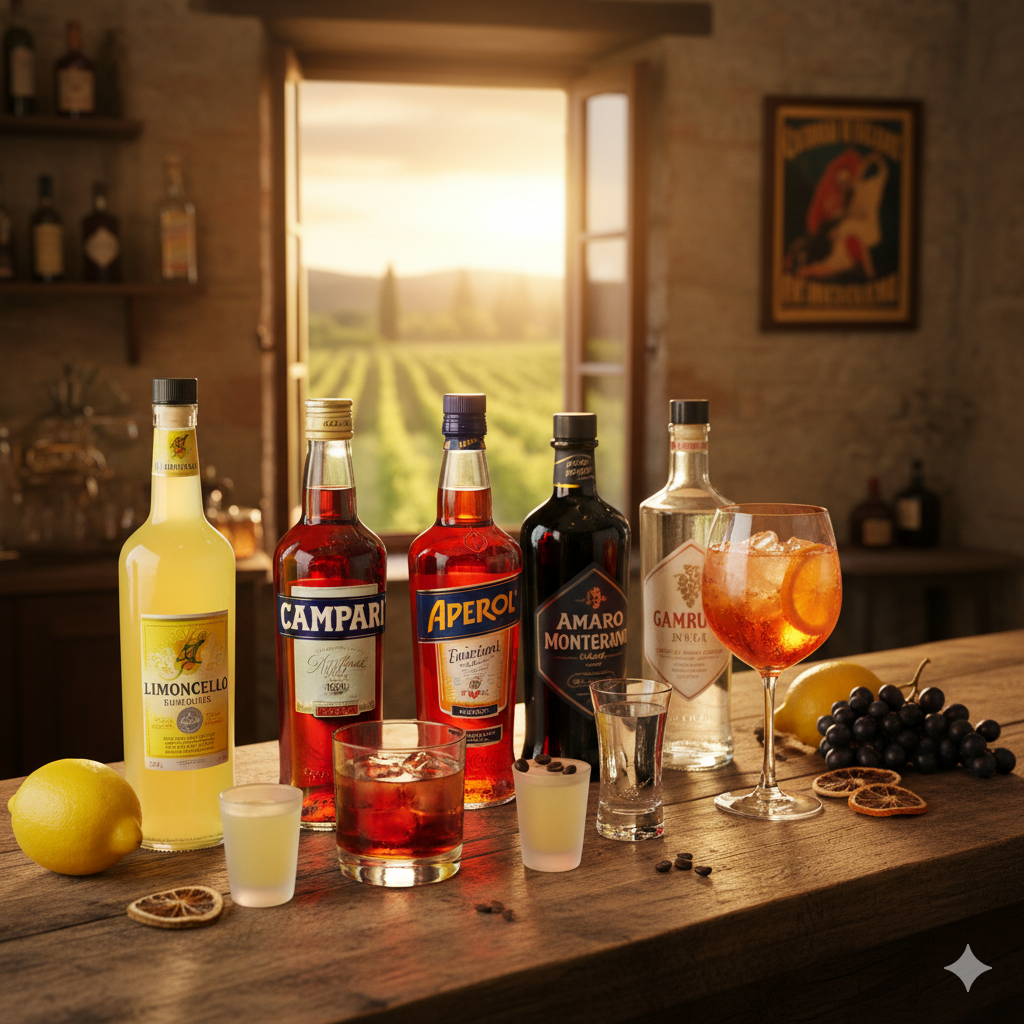In Italy, drinks are never just drinks — they are part of a ritual, a celebration of food, friendship, and culture. From the lively aperitif before dinner to the soothing digestif after a meal, Italian liquors embody centuries of history and hospitality. Each bottle carries not just flavor, but also a reflection of Italian lifestyle and tradition.
This guide will walk you through the differences between liquor and liqueur, the most iconic Italian aperitivi and digestivi, some regional gems, and how these drinks are woven into everyday Italian life.
📌Liquor vs. Liqueur: Clearing the Confusion
Many people use “liquor” and “liqueur” interchangeably, but they are not the same:
Liquor: A strong distilled spirit, usually unsweetened, with a high alcohol content (around 40% ABV or more). Example: Grappa.
Liqueur: A spirit that has been flavored with fruit, herbs, or spices, and sweetened for balance. It usually has a lower ABV between 15–35%. Examples: Limoncello, Amaro, Sambuca.
This means that household names like Aperol, Campari, and Amaro are actually liqueurs, not liquors.
📌The Italian Aperitivo: Opening the Appetite
The word aperitivo translates to “opener,” which perfectly describes the role of these drinks. Bitter or dry, they are designed to awaken the palate and prepare you for an evening meal. Italians often enjoy them with simple snacks like cheese, olives, or cured meats during late afternoon gatherings.
📌Campari – Milan’s Red Signature
Created: Milan, 1860s
Flavor Notes: Bold bittersweet taste, layered with herbs and citrus
Famous Drinks: Stars in the Negroni and Americano cocktails
Learn more on the official Campari site
📌Aperol – The Bright and Refreshing Spritz Staple
Created: Padua, 1919
Flavor Notes: Lighter and sweeter than Campari, with orange and rhubarb aromas
Best Enjoyed As: The beloved Aperol Spritz (Aperol, Prosecco, soda, orange garnish)
Official Aperol Spritz recipe
📌Vermouth – Turin’s Herbal Icon
Created: Turin, Piedmont
Characteristics: Fortified wine flavored with a signature mix of botanicals, available in both sweet and dry versions
Typical Serving: Over ice with citrus, or as a key base for cocktails like the Martini and Negroni
📌The Digestivo: Closing the Meal the Italian Way
Once the last bite of dinner is gone, Italians often move on to a digestivo, a drink designed to settle the stomach and round off the meal. These herbal or citrus-based spirits once had medicinal uses and today remain an essential dining tradition.
📌Amaro – The Herbal Legend
Meaning: “Bitter” in Italian
History: Evolved from medieval herbal remedies made by monks
Famous Variations:
Amaro Montenegro – Mild, floral, and approachable
Fernet-Branca – Strong, very bitter, and globally loved by enthusiasts
Averna – A Sicilian style, smooth and citrusy
📌Limoncello – A Taste of Southern Sunshine
Region: Amalfi Coast and Sorrento
Made From: Lemon peels steeped in alcohol, blended with sugar
Tradition: Served ice-cold in small chilled glasses, often as a dessert companion
📌Grappa – Italy’s Rustic Spirit
Category: Distilled liquor, not a liqueur
Origin: Northern Italy (Veneto, Trentino, Friuli)
Made From: Grape pomace (skins, seeds, and stems from winemaking)
Custom: Sipped neat or combined with coffee to make a Caffè Corretto
📌Regional Specialties Worth Discovering
Italy’s remarkable diversity means nearly every region has its own traditional spirit, tied to local ingredients and folklore.
Amaretto (Lombardy): Smooth, sweet, almond-flavored liqueur, with Disaronno as its most famous label.
Sambuca (Lazio): Licorice-like with star anise, often served con la mosca with three coffee beans (representing health, luck, and prosperity).
Mirto (Sardinia): Deep-red liqueur from wild myrtle berries, unique to the island.
Liquore Strega (Benevento): Bright yellow herbal liqueur, flavored with saffron, connected to legends of witches.
📌More Than Drinks: A Cultural Ritual
Enjoying Italian liquor is rooted in tradition and timing:
Aperitivo: A moment for socializing, accompanied by light bites and conversation.
Digestivo: A calm, reflective pause after dining, savored slowly and mindfully.
Together, this rhythm captures the dolce vita — the Italian philosophy of living life sweetly, fully, and joyfully.
📌FAQs About Italian Liquors
1. Which Italian liquors are most famous worldwide?
Aperitivo favorites like Campari and Aperol, and digestivi like Limoncello and Amaro.
2. What’s the key difference between aperitivo and digestivo?
Aperitivo prepares the appetite before dining, while digestivo aids digestion afterward.
3. Is Limoncello a liquor or a liqueur?
Limoncello is a liqueur, since it is sweetened and flavored.
4. Which liquor is used in a Negroni cocktail?
The recipe features Campari along with gin and sweet vermouth.
5. What is considered the strongest Italian liquor?
Grappa, which can range from 40% to 60% ABV, is one of Italy’s most powerful spirits.
📌Final Thoughts
Italian liquor are not just about alcohol; they’re about tradition, timing, and shared experiences. The buzzing sparkle of an Aperol Spritz marks the start of an evening, while the complex bitterness of an Amaro gracefully closes the night. With every sip, you experience a living piece of Italian liquor culture — a true taste of la dolce vita.
For more Italian Drinks Check out – Italian Beer: The Untold Secrets of Tradition, Innovation, and a Craft Revolution

